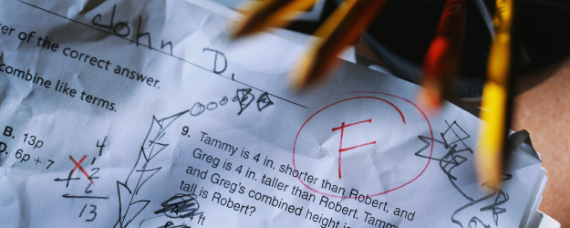- 标签:

英语感叹句是用来示意猛烈情绪的句子,如喜怒哀乐等等,句末用感叹号。英语语序基本上从命以下这一顺次:6(when)1(who)2(what)3(whom)4(how)5(where)6(when)。
一、感叹句
What +名词+主语+谓语
What a beautiful girl she is!
How + 形容词+主语+谓语
How beautiful the girl is!
机关
由感叹词what启发的感叹句。
what润饰名词或名词短语,有以下两种格式方式:
1. What+a(an)+(形容词)+单数可数名词+主语+谓语!或是:What+名词词组+主语+谓语!如:
What a fine day it is!
2. What+(形容词)+可数名词复数或不可数名词+主语+谓语!
What kind women they are!
What nice music it is!
由How启发的感叹句。
how用来润色形容词、副词或动词。其组织是:How+形容词(副词)+主语+谓语!
How hard the workers are working!
How clever the girl is!
How quickly the boy is writing!
注意:当how点缀动词时,动词不随着感叹词提到主语以前。
How fast the runner runs!
what与how向导的感叹句,日常情况下能够互相更调,更调后事理稳固。(详细见下)如:
What an interesting story it is!==How interesting the story is!
what a beautiful building it is!==How beautiful the building is!
在白话中,感叹句的主语和谓语不时简略节略。如:
What a nice present!(简略节略it is)
How disappointed!(节略she is或此外可作本句主、谓的词语)
用法
感叹句多以how或what启发,但在白话中,另有部分特别的感叹句抒发格式方式。
1.以副词here, there, in初阶的感叹句。
Here comes the bus! 公共汽车来了!
There they are! 他们在何处呢!
2.以疑问词who初阶,暗示骇怪。
Who else will read such a book! 谁还会读云云的书!
3.以情态动词may起头,默示盼望。
May you both be happy! 祝二位甜蜜。
May you succeed! 祝你乐成!
4.否认疑问句用作感叹句时,它的事理是一定的;但一定疑问句用作感叹句在美国英语中比较常见。
Aren’t they sweet! 他们多可爱啊!
Am I hungry! 我饿极了!
5.部分短语用作感叹句。
Dear me! 哎呀! My goodness! 嗳呀!
None of your nonsense! 不要胡说了!
6.部分作表语的因素用作感叹句。
Just my luck! 又倒楣了!
Sorry, my mistake! 抱歉,是我的错!
7.以从句透露表现的感叹句。譬喻:
As if were my fault!不像是我的错似的!
To think a scandal of this sort should be going on under my roof!真想不到这种丑事公然出在我们家里!
二、语序
Part I:一个公式
6-1-2-3-4-5-6
6(when)1(who)2(what)3(whom)4(how)5(where)6(when)
诠释:6的坐标很灵便,能够放前,也能够放后。
示例:
I ate an apple.
I ate an apple with a fork.
I ate an apple with a fork in the kitchen.
I ate an apple with a fork in the kitchen this morning.
以上四个句子从1-2-3模式一直到1-2-3-4-5-6模式,请网友一一翻译一下,留神对照英语规律与汉语规律的差别。
结论:英语和汉语在抒发的最重心内容上是相反的:即一个句子的1-2-3是类似的;然而,在有了4-5-6后,汉语抒发方式与英语这个天然抒发次序产生了庞大的词序差距:汉语次新闻先呈现;英语主新闻先呈现。
再如:
我爱好谁人女孩子
我喜爱阿谁穿红衣服的女孩子
我喜爱阿谁穿红衣服的不喜爱我的女孩子
这三个句子的中心内容都是:I like that girl.(与:“我爱好阿谁女孩子”词序相似,然而,在添加了其余一些后,抒发按次全变样了!)
再如:
我打死一只苍蝇
我用手打死一只苍蝇
我用手打了三次打死一只苍蝇
我用手打了三次并在我辅佐的帮助下打死了一只苍蝇
这四个句子的焦点内容都是:I killed a fly.(与“我打死一只苍蝇”词序一律,可是,在添加了其余一些后,抒发顺次全变样了!)
Part II:逗号纲要
在一个句子的前方如果有内容,那么,请记着:
1.不到3个单词时,能够用逗号与背面句子隔离开来,也能够不需要逗号隔离,详细景况按照讲话人自个断定的停留口气是非来断定。
示例1:At last he stopped playing the piano.
示例2:Sadly he picked up the broken glass and went into the room.
2.到达或超出跨越3个单词时,必须用逗号与后背句子隔离开来。
示例1:In the end, I could not bear it.
示例2:To my surprise, he bought me a ticket!
Part III:1个main verb纲目
理论上讲:一个句子只应该有一个为主的动词(即2)。
然而,现实利用的过程中,我们会发现一个句子中有多个动词,此时就需要:
标帜明确这些动词彼此间的逻辑关连!
这边的逻辑关连有两种环境:
1.并列(即:将这些动词视为职位雷同;一样平常体例为使用and衔接)
2.隶属(即:捐躯某个或某些动词,将其措置成相符隶属关系的办法,从而保证为主的动词;平常办法为使用动词三大非谓语方式:动词的ing方式、动词的过去分词方式、动词的不定式方式)
1.并列关联示例
示例1:Isatdown beside her said nothing.
解析:sat与said之间没有标帜逻辑关连,舛讹!能够添加and,产生并列关连,即:
Isatdown beside her and said nothing.
示例2:I entered the room saw mother sit there wait for me come back.
解析:这里有5个动词,都没有标志逻辑联系,过失!经过解析,我们看到:entered和saw能够并列,由于它们含有合伙的1(I);sit和wait能够并列,由于它们含有合伙的
1(mother),但这两组动词之间就不能再并列了,原因无奈这么做。这就意味着:这句话里的动词有的能够并列,而有的不能够。
示例3:I opened the bag took out some paper and a pen, sat down started take notes.
解析:opened,took out,sat down,started这四个动词含有合伙的1(I),并且都是1直接运用或发出的行为,以是,能够选拔并列联系;但take由于有个过渡层,所以并列处置不合适。
2.从属关系示例
示例1:I sat down beside her said nothing.
解析:动词关联纷乱,倘若想保证said,则必要就义反面,如:
I sat down beside her, saying nothing.
倘若保证2背面,则殉国前方:
Sitting down beside her, I said nothing.
示例2:To quit smoking, I eat candies.
三、虚拟语气句型
if only后的句子用虚拟语气if only 与 I wish相通,也用于默示与本相类似的理想,厥后所虚拟语气的时态与 wish后所接时态的处境类似:If only she had had more courage! 她再勇敢部分就好了。If only I had listened to my parents! 我倘使那时听了爸妈的话就好了。If only she would go with me! 她倘使甘心和我一道去就好了!注:if only 泛泛自力使用,没有主句。
as if (though) 从句用虚拟口气▲ 根基用法以as if (as though)向导的方法状语从句或表语从句,偶尔用虚拟口气,若默示与如今真相相似,谓语动词用普通昔日时;若默示与昔日真相相似,用昔日完成时;默示将来的或者性不大,用would (might, could)+动词事实:He acts as if he knew me. 他显得理解我似的。They treat me as though I were a stranger. 他们待我如陌生人。He talks as if he had been abroad. 他说起话来似乎曾经出过国。注:两点阐述(1) 从句所默示的内容若为真相或或者为真相,也可用论述口气:It looks as if we’ll be late. 我们宛如彷佛要迟到了。(2) 留意 It isn’t as if…的翻译:It isn’t as if he were poor. 他不像穷的模样形状(或他又不穷)。
It’s time后的从句用虚拟语气▲ 根基用法从句谓语通常用畴昔式默示而今或改日,偶尔也用畴昔进行时或“should+动词究竟”(较稀奇,且should不行简略节略),其意为“(早)该干某事了”:It’s time we went [were going, should go]. 我们该走了。It’s time I was in bed. 我该上床睡了。(不消were)
would rather后句子用虚构口气在would rather, would sooner, would just as soon 后的that从句中, 句子谓语习惯上要用虚构口气, 示意”宁可做甚么” ,详细用法为:▲ 平常畴前时示意目前或将来的抱负I’d rather you went tomorrow (now). 我宁可你来日诰日(目前)去。▲ 用畴前完成时表畴前的抱负I’d rather you hadn’t said it. 我真但愿你没有云云说过。
智能推荐
-

英语要怎么学才能学好(英语要怎么学)2023-03-01 学习英语时演习英语发音,随着灌音一块读;天天都抽出一小段时间来积蓄单词,一次背几个单词就能够;在网络上能够找到英语文章,学习俗谚、语法知识
-

英语句型分析的软件(英语句型分析)2023-03-03 bethatasitmay/rangefrom...to.../theway/makeuseof/tobedoing/bydoing/Itfollowsthat/
-

英语跟读软件 小学生免费(英语跟读软件)2023-03-07 英语跟读软件有好多,好比有:沪江欢乐词场、沪江小D辞书、沪江听力酷、沪江网校、谷歌翻译等等。这几款软件都会供给专业的英语跟读功能,比较恰当学习英语白话
-

英语的词组是什么意思?(英语词组是什么意思)2023-03-01 词组(短语)是指由两个以上的词语组合而成的一个有意义语法单元。英语词组都是习惯用语,它相当于我们汉语的成语,不行随便搭配
-

如何快速学英语 速成(如何快速学英语)2023-03-03 快捷学习英语,最重要的有三点:一是将自个沉浸在措辞处境中,多听多看多读;二是多记多背,诳骗细碎时间背单词、看语法;三是为自个设定方向,鞭策自个在一段时间内抵达某个
-

现在完成时是什么意思(现在完成时是什么)2023-03-07 如今完成时是英语中的一个紧张时态,是昔时爆发或已经完成的行动对如今变成的劝化或了局。小编为网友整理了一系列如今完成时的英语语法知识,一起来瞧瞧吧
-

什么英语翻译软件最好用最准确(什么英语翻译)2023-03-04 甚么英语翻译:what(透露表现疑难)。例句:Whatdoyouwant?你要甚么?GoodLord,whathaveyoudonetoyourhair!天啊,你
-

高中英语语法填空技巧(英语语法填空技巧)2023-03-06 英语语法填空按照区别题型首要分为十大解题技巧。如:名词、动词、代词、形容词、副词、数词比较级转变、词的派生、不变短语构造、从句向导词、短语动词构造等
-

成人教育英语四级好考吗(英语四级好考吗)2023-03-01 英语四级的难度和词汇量、语法的操纵密切相关。英语基本亏弱,必要操纵起码2词汇,夯实语法基本,多背诵作文和翻译;中等水平,必要有针对性的招考妙技训练
-

介绍自己的英语作文5句话(介绍自己的英语作文)2023-03-02 用英语打招呼;个人讲解:岁数、老家、性格、喜爱、业余时间分派;能力讲解:学历、专业、长于周围,语法与逻辑精确
-

零基础英语自学方法过程(零基础英语自学方法)2023-03-02 首先,熟练26个英文字母;之后,学习音标,操纵元音和子音;下面,学习语法,做语法练习题;同时,做到有始有终,担保天天学习
-

学英语先学什么最适合(学英语先学什么)2023-03-02 首先,熟谙26个英文字母;之后,学习音标,操纵元音和子音;下面,学习语法,做语法练习题;同时,做到有始有终,担保每日学习
